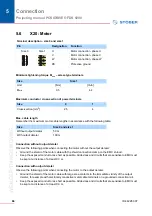
Connection
Projecting manual POSIDRIVE® FDS 5000
ID 442269.07
WE KEEP THINGS MOVING
75
5
5.10
X22: DC link coupling
When you have axes in your system which operate in combination and are continuously regenerative and
motor-driven, the DC link coupling may offer advantages. The DC link coupling takes the excess power and
offers it to other axes as drive power instead of converting it into heat via a braking resistor. Remember that
you will need a braking resistor to absorb the power peaks when all drives in the DC link coupling brake at the
same time.
DANGER!
Danger of device damage! When single-phase and three-phase devices are coupled, the single-phase
devices will be destroyed.
Only use three-phase devices for the DC link coupling!
NOTICE
Danger of device damage!
Because the failure of one device could damage other devices, failure of a device must cause the entire DC
link compound system to be disconnected from the power supply.
Make a note of the wiring and parameterization of relay 1 in Section Principal circuit diagram (X1.1 and
X1.2).
After a failure, replace all the devices in a group.
Information
Remember that the DC link coupling described here can only be used with the device families MDS
5000, SDS 5000 and FDS 5000.
Information
Remember that the parameter
A38 DC power-input
must be set before the DC link coupling can
function correctly:
Group 1:
A38
=
0: inactive
Groups 2 and 3:
A38
=
1: active
See the description of the parameter.
















































